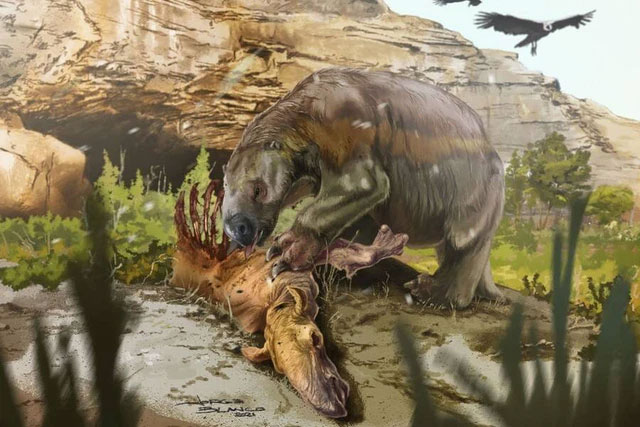Discovered the first evidence of ancient giant sloths are not vegetarian animals
Today's sloths are small and slow-moving. They are vegetarians and feed mainly on leaves and fruit, although some species have been known to eat bird eggs as infrequently as they can. But their ancient ancestors were real giants - giant ground sloths and according to a new study, scientists have proven that they are omnivores and are very active carnivores.
Lead author of the study Julia Tejada, a research associate at the American Museum of Natural History and a postdoctoral researcher at the University of Montpellier, said: "Are they scavengers? or those who specialize in stealing the prey of other predators, before we can say for sure, more detailed and in-depth studies are still needed."
"But now we have strong evidence against the long-held hypothesis that the giant ground sloth is a vegan animal."

Long thought to be vegetarians, new evidence suggests giant sloths are also scavengers. Mylodon is an extinct genus of ground sloth in the family Mylodontidae, known from Patagonia in Chile and Argentina in southern South America. With a total length of 3 to 4 m, it is one of the most famous and largest representatives of the group. The oldest finds probably date to the Pleistocene
To determine what ancient terrestrial sloths ate, the researchers analyzed the amount of nitrogen isotopes found in their fur. They looked for an isotope called nitrogen-15, which indicates an animal's position in the food chain - the more this isotope is present, the more meat it eats.
Although the researchers found that some giant ground sloths, such as Nothrotheriops shastensis of North America, were actually herbivores, they also discovered that several other giant ground sloths were carnivores. complex. One species of ground sloth found in Patagonia, Mylodon darwinii (M. darwinii), also known as Darwin's ground sloth, has enough nitrogen-15 in its plumage to indicate that it eats both plants and meat.
This giant ground sloth was discovered by Charles Darwin in 1832 and it was later named after him - they are animals that weigh 2,200 to 4,400 pounds (1 to 2 tons) and can grow up to 13 feet (4 feet) long. meters). It lived in South America from 1.8 million to 10,000 years ago during the Pleistocene epoch.
"The results of the study clearly indicate that Mylodon is not a vegan, but is instead an omnivore," explained Tejada and her co-authors in a published study. in Scientific Reports.

Mylodon and its relatives are the dominant group of ground sloths in South America. They are distinguished from other ground sloths by the presence of upper canines, triangular cheek teeth, and a small tip toe on the hind limbs. Two closely related genera, Paramylodon and Glossotherium, were widely distributed and even spread to many parts of North America.
The team suspects that M. darwinii is more of a scavenger than a predator. The lack of bones in the sloth's feces suggests that it either scavenged the carcass of other animals that were killed or may have obtained animal protein from eating eggs.
While the new findings are surprising, they also answer some longstanding questions about how these ancient giant ground sloths survived.
For example, M. darwinii has small teeth - the teeth and stomach seem too small for a thriving herbivore. This would seem to pose problems for vegans, but it is advantageous for omnivores, allowing them to easily digest high-energy foods. like meat.
Furthermore, scientists have long suspected that there simply wasn't enough vegetation for all the herbivores that lived in South America at the same time as the giant ground sloth.
Therefore, sloths can eat both meat and plants. Indeed, its varied diet has helped the animal survive despite scarce resources. The researchers also suggest that it may have begun to adapt to eating meat to survive in resource depletion.
"These results provide the first direct evidence of omnivores in ancient sloths, and, accordingly, the need to reassess the entire ecological structure of ancient mammal communities. species in South America," said Tejada, "because the giant ground sloth represented a major component of these ecosystems during the past few million years".
The researchers hope to learn more about their feeding habits and shed light on how giant sloths once lived. Certainly, there is much more to learn about these mysterious giants.
- Discovered many giant animals living in the plateau
- Ancient 'beast' version of 4 meek modern creatures
- The sloths but diligent
- Discovered 22 giant sloths preserved in their own feces
- Fossil discovery of a giant sloth in Mexico
- Vegetarian vegetarian season how good for health
- Discovered a huge 'graveyard' during the ice age
- How is vegetarian right?
- This animal will make you fly your head with just one hand
- Spiders eat 'vegetarian'
- Detecting ancient whale fossils with strange shapes
- Ancient crocodiles are vegetarian animals
 Discovered an ancient centipede fossil 99 million years old
Discovered an ancient centipede fossil 99 million years old Discovered bat-like dinosaurs in China
Discovered bat-like dinosaurs in China Discovered a 200-year-old bronze cannon of the coast
Discovered a 200-year-old bronze cannon of the coast Discover 305 million-year-old spider fossils
Discover 305 million-year-old spider fossils